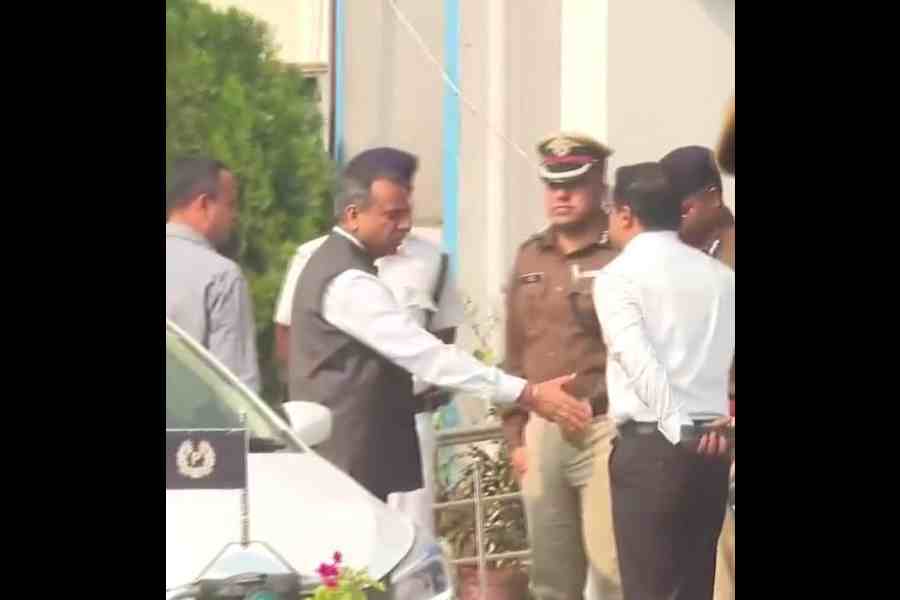Terrifying though the coronavirus may be, it can be turned back. China, South Korea, Singapore and Taiwan have demonstrated that, with furious efforts, the contagion can be brought to heel.
Whether they can keep it suppressed remains to be seen. But for the US to repeat their successes will take extraordinary levels of coordination and money from the country’s leaders, and extraordinary levels of trust and cooperation from citizens.
It will also require international partnerships in an interconnected world.
There is a chance to stop the coronavirus. This contagion has a weakness.
Although there are incidents of rampant spread, as happened on the cruise ship Diamond Princess, the coronavirus more often infects clusters of family members, friends and work colleagues, said Dr David L. Heymann, who chairs an expert panel advising the World Health Organisation on emergencies.
No one is certain why the virus travels in this way, but experts see an opening nonetheless.
“You can contain clusters,” Dr Heymann said. “You need to identify and stop discrete outbreaks, and then do rigorous contact tracing.”
But doing so takes intelligent, rapidly adaptive work by health officials, and near-total cooperation from the populace. Containment becomes realistic only when Americans realise that working together is the only way to protect themselves and their loved ones.
In interviews with a dozen of the world’s leading experts on fighting epidemics, there was wide agreement on the steps that must be taken immediately.
Those experts included international public health officials who have fought AIDS, malaria, tuberculosis, flu and Ebola; scientists and epidemiologists; and former health officials who led major American global health programs in both Republican and Democratic administrations.
Americans must be persuaded to stay home, they said, and a system put in place to isolate the infected and care for them outside the home. Travel restrictions should be extended, they said; productions of masks and ventilators must be accelerated, and testing problems must be resolved.
But tactics like forced isolation, school closings and pervasive GPS tracking of patients brought more divided reactions.
It was not at all clear that a nation so fundamentally committed to individual liberty and distrustful of government could learn to adapt to many of these measures, especially those that smack of state compulsion.
“The American way is to look for better outcomes through a voluntary system,” said Dr Luciana Borio, who was director of medical and biodefence preparedness for the National Security Council before it was disbanded in 2018.
“I think you can appeal to people to do the right thing.”
In the week since the interviews began, remarkable changes have come over American life. State governments are telling residents they must stay home. Non-essential businesses are being shuttered.
The streets are quieter than they have been in generations, and even friends keep a wary distance. What seemed unthinkable just a week ago is rapidly becoming the new normal.
What follows are the recommendations offered by the experts interviewed by The Times.
Listen to scientists
The White House holds frequent media briefings to describe the administration’s progress against the pandemic, often led by President Trump or Vice-President Mike Pence, flanked by a rotating cast of officials.
Many experts, some of whom are international civil servants, declined to speak on the record for fear of offending the President.
But they were united in the opinion that politicians must step aside and let scientists both lead the effort to contain the virus and explain to Americans what must be done.
Just as generals take the lead in giving daily briefings in wartime — as Gen. Norman Schwarzkopf did during the Persian Gulf war — medical experts should be at the microphone now to explain complex ideas like epidemic curves, social distancing and off-label use of drugs.
The microphone should not even be at the White House, scientists said, so that briefings of historic importance do not dissolve into angry, politically charged exchanges with the press corps, as happened again on Friday.
Instead, leaders must describe the looming crisis and the possible solutions in ways that will win the trust of Americans.
Above all, the experts said, briefings should focus on saving lives and making sure that average wage earners survive the coming hard times — not on the stock market, the tourism industry or the President’s health. There is no time left to point fingers and assign blame.
“At this point in the emergency, there’s little merit in spending time on what we should have done or who’s at fault,” said Admiral Tim Ziemer, who was the coordinator of the President’s Malaria Initiative from 2006 until early 2017 and led the pandemic response unit on the National Security Council before its disbanding.
“We need to focus on the enemy, and that’s the virus.”
Stop transmission
The next priority, experts said, is extreme social distancing.
If it were possible to wave a magic wand and make all Americans freeze in place for 14 days while sitting six feet apart, epidemiologists say, the whole epidemic would sputter to a halt.
The virus would die out on every contaminated surface and, because almost everyone shows symptoms within two weeks, it would be evident who was infected. If we had enough tests for every American, even the completely asymptomatic cases could be found and isolated.
The crisis would be over.
Obviously, there is no magic wand, and no 300 million tests. But the goal of lockdowns and social distancing is to approximate such a total freeze.
To attempt that, experts said, travel and human interaction must be reduced to a minimum.
Italy moved incrementally: Officials slowly and reluctantly closed restaurants, churches and museums, and banned weddings and funerals. Nonetheless, the country’s death count continues to rise.
The US is slowly following suit. International flights are all but banned, but not domestic ones. California has ordered all residents to stay at home; New York was to shutter all non-essential businesses on Sunday evening.
But other states have fewer restrictions, and in Florida, for days spring break revellers ignored government requests to clear the beaches.
On Friday, Dr Anthony S. Fauci, chief medical adviser to the White House Coronavirus Task Force, said he advocated restrictive measures all across the country.
In contrast to the halting steps taken here, China shut down Wuhan — the epicentre of the nation’s outbreak — and restricted movement in much of the country on January 23, when the country had a mere 500 cases and 17 deaths.
It’s rapid action had an important effect: With the virus mostly isolated in one province, the rest of China was able to save Wuhan.
Even as many cities fought their own smaller outbreaks, they sent 40,000 medical workers into Wuhan, roughly doubling its medical force.
In a vast, largely closed society, it can be difficult to know what is happening on the ground, and there is no guarantee that the virus won’t roar back as the Chinese economy restarts.
But the lesson is that relatively unaffected regions of the US will be needed to help rescue overwhelmed cities like New York and Seattle. Keeping these areas at least somewhat free of the coronavirus means enacting strict measures, and quickly.
City hot spots
Within cities, there are dangerous hot spots: One restaurant, one gym, one hospital, even one taxi may be more contaminated than many identical others nearby because someone had a coughing fit inside.
Each day’s delay in stopping human contact, experts said, creates more hot spots, none of which can be identified until about a week later, when the people infected there start falling ill.
To stop the explosion, municipal activity must be curtailed. Still, some Americans must stay on the job: doctors, nurses, ambulance drivers; police officers and firefighters; the technicians who maintain the electrical grid and gas and phone lines.
The delivery of food and medicine must continue, so that people pinned in their homes suffer nothing worse than boredom. Those essential workers may eventually need permits, and a process for issuing them, if the police are needed to enforce stay-at-home orders, as they have been in China and Italy.
People in lockdown adapt. In Wuhan, apartment complexes submit group orders for food, medicine, diapers and other essentials.
Shipments are assembled at grocery warehouses or government pantries and dropped off. In Italy, trapped neighbours serenade one another.
It’s an intimidating picture. But the weaker the freeze, the more people die in overburdened hospitals — and the longer it ultimately takes for the economy to restart.
South Korea avoided locking down any city, but only by moving early and with extraordinary speed. In January, the country had four companies making tests, and as of March 9 had tested 210,000 citizens — the equivalent of testing 2.3 million Americans.
As of the same date, fewer than 9,000 Americans had been tested.
Everyone who is infected in South Korea goes into isolation in government shelters, and phones and credit card data are used to trace their prior movements and find their contacts. Where they walked before they fell ill is broadcast to the cellphones of everyone who was nearby.
Anyone even potentially exposed is quarantined at home; a GPS app tells the police if that person goes outside. The fine for doing so is $8,000.
British researchers are trying to develop a similar tracking app, albeit one more palatable to citizens in western democracies.
Testing mess
Testing must be done in a coordinated and safe way, experts said. The seriously ill must go first, and the testers must be protected.
In China, those seeking a test must describe their symptoms on a telemedicine website. If a nurse decides a test is warranted, they are directed to one of dozens of “fever clinics” set up far from all other patients.
Personnel in head-to-toe gear check their fevers and question them. Then, ideally, patients are given a rapid flu test and a white blood cell count is taken to rule out influenza and bacterial pneumonia.
Then their lungs are visualised in a CT scanner to look for “ground-glass opacities” that indicate pneumonia and rule out cancer and tuberculosis. Only then are they given a diagnostic test for the coronavirus — and they are told to wait at the testing centre.
The results take a minimum of four hours; in the past, if results took overnight, patients were moved to a hotel to wait — sometimes for two to three days, if doctors believed retesting was warranted. It can take several days after an exposure for a test to turn positive.
In the US, people seeking tests are calling their doctors, who may not have them, or sometimes waiting in traffic jams leading to store parking lots. On Friday, New York City limited testing only to those patients requiring hospitalisation, saying the system was being overwhelmed.
Isolate infected
As soon as possible, experts said, the US must develop an alternative to the practice of isolating infected people at home, as it endangers families. In China, 75 to 80 per cent of all transmission occurred in family clusters.
That pattern has already repeated itself here. Seven members of a large family in New Jersey were infected; four have already died. After a lawyer in New Rochelle, New York, fell ill, his wife, son and daughter all tested positive.
Instead of a policy that advises the infected to remain at home, as the Centres for Disease and Prevention now does, experts said cities should establish facilities where the mildly and moderately ill can recuperate under the care and observation of nurses.
Wuhan created many such centres, called “temporary hospitals”, each a cross between a dormitory and a first-aid clinic.
They had cots and oxygen tanks, but not the advanced machines used in intensive care units.
American cities now have many spaces that could serve as isolation wards. Already New York is considering turning the Jacob K. Javits Convention Centre into a temporary hospital, along with the Westchester Convention Centre and two university campuses.
Governor Ron DeSantis of Florida said on Saturday that state officials were also considering opening isolation wards.
In China, said Dr. Bruce Aylward, leader of the World Health Organisation’s observer team there, people originally resisted leaving home or seeing their children go into isolation centres with no visiting rights — just as Americans no doubt would.
“They realised they were keeping their families safe,” he said. “Also, isolation is really lonely. It’s psychologically difficult. Here, they were all together with other people in the same boat. They supported each other.”
Find the fevers
Because China, Taiwan and Vietnam were hit by Sars in 2003, and South Korea has grappled with Mers, fever checks during disease outbreaks became routine.
In most cities in affected Asian countries, it is commonplace before entering any bus, train or subway station, office building, theatre or even a restaurant to get a temperature check. Washing your hands in chlorinated water is often also required.
“They give you a sticker afterward,” said Dr. Heymann, who recently spent a week teaching in Singapore. “I built up quite a collection.”
In China, having a fever means a mandatory trip to a fever clinic to check for coronavirus. In the Wuhan area, different cities took different approaches.
Cellphone videos from China show police officers knocking on doors and taking temperatures. In some, people who resist are dragged away by force. The city of Ningbo offered bounties of $1,400 to anyone who turned in a coronavirus sufferer.
The city of Qianjiang, by contrast, offered the same amount of money to any resident who came in voluntarily and tested positive.
Some measures made western experts queasy. It is difficult to imagine Americans permitting a family member with a fever to be dragged to an isolation ward where visitors are not permitted.
“A lot of people’s rights were violated,” Dr Borio said.
Voluntary approaches, like explaining to patients that they will be keeping family and friends safe, are more likely to work in the West, she added.
Trace the contacts
Finding and testing all the contacts of every positive case is essential, experts said. At the peak of its epidemic, Wuhan had 18,000 people tracking down individuals who had come in contact with the infected.
At the moment, the health departments of some American counties lack the manpower to trace even syphilis or tuberculosis, let alone scores of casual contacts of someone infected with the coronavirus.
Dr Borio suggested that young Americans could use their social networks to “do their own contact tracing”. Social media also is used in Asia, but in different ways.
China’s strategy is quite intrusive: To use the subway in some cities, citizens must download an app that rates how great a health risk they are. South Korean apps tell users exactly where infected people have travelled.
When he lectured at a Singapore university, Dr. Heymann said, dozens of students were in the room. But just before he began class, they were photographed to record where everyone sat.
“That way, if someone turns up infected later, you can find out who sat near them,” Dr Heymann said. “That’s really clever.”
Contacts generally must remain home for 14 days and report their temperatures twice a day.
Value of masks
American experts have divided opinions about masks, but those who have worked in Asia see their value.
There is very little data showing that flat surgical masks protect healthy individuals from disease. Nonetheless, Asian countries generally make it mandatory that people wear them. In China, the police even used drones to chase individuals down streets, ordering them to go home and mask up.
The Asian approach is less about data than it is about crowd psychology, experts explained.
All experts agree that the sick must wear masks to keep in their coughs. But if a mask indicates that the wearer is sick, many people will be reluctant to wear one. If everyone is required to wear masks, the sick automatically have one on and there is no stigma attached.
Also, experts emphasised, Americans should be taught to take seriously admonitions to stop shaking hands and hugging. The “WHO elbow bump” may look funny, but it’s a legitimate technique for preventing infection.
“In Asia, where they went through Sars, people understand the danger,” Dr Heymann said.
“It’s instilled in the population that you’ve got to do the right thing.”
Vital services
Federal intervention is necessary for some vital aspects of life during a pandemic.
Only the federal government can enforce interstate commerce laws to ensure that food, water, electricity, gas, phone lines and other basic needs keep flowing across state lines to cities and suburbs.










